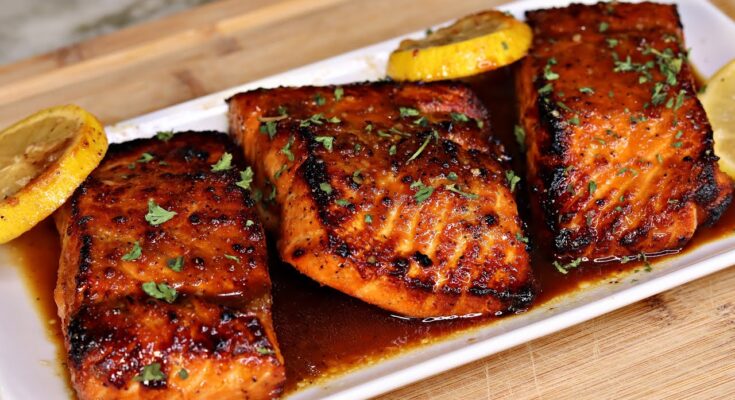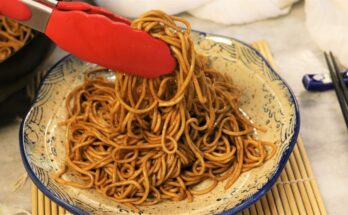Air Fry Salmon Recipe: If you’ve ever wanted to cook salmon without the fuss of preheating the oven or cleaning up greasy pans, you’re in for a treat. Air frying salmon is one of the easiest, healthiest, and most flavorful ways to enjoy this nutrient-rich fish.
This guide will walk you through everything—from choosing the right fillet to seasoning it just right and cooking it to perfection. Let’s get cooking!
Introduction to Air Frying Salmon
What Makes Air Frying Unique?
Air fryers have revolutionized the way we cook. Think of them as mini convection ovens that circulate hot air around the food, creating a crispy exterior while keeping the inside juicy. Unlike traditional frying, you don’t need a ton of oil to achieve that golden finish.
For salmon lovers, this means your fish cooks faster, holds onto more nutrients, and stays wonderfully tender without drying out. And if you’re like most people juggling a million things, the convenience is unbeatable. No need to babysit the stove—just pop it in the air fryer and go!
Benefits of Air Frying Salmon Over Traditional Methods
- Healthier Option: You’ll use little to no oil, which cuts down on calories without sacrificing flavor.
- Faster Cooking Time: Most salmon fillets are ready in 10 minutes or less.
- Consistent Results: No burnt edges or undercooked centers.
- Easy Cleanup: One basket, minimal mess—what’s not to love?
- Perfect Texture: Crispy edges, tender and flaky inside.
Whether you’re cooking for yourself or impressing guests, air-fried salmon is the foolproof choice.
Ingredients You’ll Need
Basic Ingredients
Here’s a list of essentials you’ll need to make a basic, delicious air-fried salmon:
- Salmon fillets (skin-on or skinless, your choice)
- Olive oil (just a drizzle)
- Salt (to taste)
- Black pepper (freshly ground for best flavor)
- Garlic powder (adds a little zing)
- Lemon wedges (for garnish and a burst of freshness)
These are your foundational ingredients—simple, clean, and tasty. If you’re just starting out, this combination works beautifully.
Optional Add-ons for Flavor Boost
Want to take your flavor game up a notch? Here are some extra seasonings and toppings to experiment with:
- Paprika or smoked paprika for a smoky kick
- Chili flakes if you like it spicy
- Fresh herbs like dill, parsley, or cilantro
- Soy sauce or teriyaki glaze for an Asian twist
- Honey mustard glaze for something sweet and tangy
You can mix and match based on your mood or what you’ve got in the pantry. That’s the beauty of it—air-fried salmon is super versatile!
Choosing the Right Salmon
Wild vs Farm-Raised Salmon
When you’re standing in the seafood aisle or at the fish counter, the first choice you’ll need to make is: wild or farm-raised?
- Wild Salmon: Typically leaner, more flavorful, and higher in minerals like potassium and zinc. It has a deeper red color and a firmer texture.
- Farm-Raised Salmon: Usually fattier, which can help it stay moist during cooking. It’s also more affordable and easier to find year-round.
Both have their pros and cons, and the right pick depends on your preference, budget, and how sustainable you want your dinner to be.
Fresh vs Frozen
Don’t sleep on frozen salmon—it can be just as good as fresh if you handle it right.
- Fresh Salmon: Great if you’re using it the same day. Check for bright color, no fishy smell, and firm texture.
- Frozen Salmon: Budget-friendly and super convenient. Just make sure to thaw it properly overnight in the fridge for best results.
No matter what type you choose, make sure the fillets are uniform in size so they cook evenly in the air fryer.
Prepping the Salmon Before Air Frying
Cleaning and Drying
This is a crucial step people often skip. Rinse your salmon gently under cold water and pat it thoroughly dry with paper towels. Why is drying important? Because excess moisture creates steam, and steam ruins that beautiful air-fried texture you’re going for.
You want your salmon surface dry so the seasoning sticks better and you get that delicious golden crust.
Marinating or Seasoning Options
There are two main routes here: dry seasoning or marinating. Both work wonders, and it just depends on how much time you have.
Quick Dry Seasoning:
- Drizzle with olive oil.
- Sprinkle salt, pepper, garlic powder, and paprika.
- Let it sit for 10 minutes before air frying.
Flavorful Marinade (if you have more time):
- Mix soy sauce, olive oil, honey, garlic, and lemon juice.
- Pour it over the salmon and let it marinate for 30–60 minutes in the fridge.
- Pat dry before placing it in the air fryer to avoid excess moisture.
Both approaches will leave you with lip-smacking flavor, but marinating adds a deeper, more complex profile if you’re willing to wait.
Step-by-Step Guide to Air Fry Salmon
Step 1: Preheat the Air Fryer
Don’t skip this step! Preheating ensures even cooking and helps create that nice crisp on the outside. Most air fryers have a quick preheat function. Set it to 375°F (190°C) and let it warm up for about 3–5 minutes.
If your air fryer doesn’t have a preheat button, just run it empty at your desired cooking temperature for a few minutes before adding your food.
Step 2: Place the Salmon Properly
This part is more important than you think. How you lay your salmon in the air fryer can make or break your meal. If your air fryer has a basket, place the salmon skin-side down. If it’s a tray model, you might want to line it with parchment paper or lightly brush it with oil to prevent sticking.
Tips for arranging the salmon:
- Do not overcrowd the basket. Each fillet needs space so hot air can circulate around it.
- Skin-side down ensures the skin gets crispy and acts like a natural barrier to protect the delicate meat.
- Use a spatula to gently lay the fillet down—don’t just toss it in there.
This placement method helps the fish cook evenly and keeps the exterior crispy, not soggy. If you’re cooking multiple fillets, make sure they aren’t overlapping. Cook in batches if needed.
Step 3: Set the Timer and Temperature
Now to the nitty-gritty. Cooking salmon in the air fryer is fast, but timing matters. Here’s a general guide:
- Temperature: 375°F (190°C)
- Cook Time: 7 to 10 minutes
The exact time depends on the thickness of your fillet. For example:
- ½-inch thick: 7 minutes
- 1-inch thick: 8–10 minutes
You don’t need to flip the salmon unless your air fryer model recommends it. The skin acts as a shield and allows even cooking from the bottom up.
If your fillet is particularly thick, you can reduce the temperature slightly and add an extra minute or two. This ensures it cooks through without burning the outside.
Pro tip: Avoid opening the fryer too often. Let it cook undisturbed to lock in moisture and build that crusty exterior.
Step 4: Check for Doneness
Wondering how to tell when it’s perfectly cooked? There are a few easy signs:
- The fish flakes easily with a fork.
- The color changes from translucent to opaque.
- The internal temperature reaches 125°F (52°C) for medium or 145°F (63°C) for well-done.
Use a meat thermometer for the most accurate result. Insert it into the thickest part of the fillet without touching the skin or pan.
If you don’t have a thermometer, just flake the fish with a fork at the center—if it pulls apart easily and looks opaque, it’s done.
Be careful not to overcook. Dry salmon is a buzzkill. The air fryer’s intense heat can make the difference between juicy and jerky in just one minute.
Step 5: Let It Rest
Yes, even salmon needs a little downtime.
After pulling your salmon out of the air fryer, let it rest for about 2–3 minutes before serving. This helps the juices redistribute throughout the fillet, giving you that melt-in-your-mouth texture.
Skipping this step can cause the juices to run out when you cut into it, leaving your fish dry. Plus, resting cools it slightly, so it doesn’t burn your mouth on the first bite.
During this time, you can plate your sides—think roasted veggies, quinoa, mashed potatoes, or a fresh salad.
Pro plating idea: Top your salmon with a lemon wedge, a sprinkle of herbs, and a light drizzle of olive oil or sauce for a gourmet look.
Serving Suggestions for Air Fryer Salmon
Healthy and Delicious Side Dishes
Now that you’ve nailed your salmon, what should you serve it with? Salmon is incredibly versatile and pairs well with tons of sides, from hearty grains to crisp salads.
Here are some healthy favorites:
- Roasted vegetables: Think broccoli, asparagus, or Brussels sprouts tossed in olive oil, garlic, and a pinch of sea salt.
- Quinoa or brown rice: These grains soak up the salmon’s natural juices and make for a filling meal.
- Sweet potato mash: A perfect contrast in flavor and texture.
- Zucchini noodles: If you’re watching your carbs, zoodles are a fresh, fun option.
- Mixed green salad: Toss with vinaigrette, nuts, and cranberries for a refreshing bite.
Not into veggies? Go Mediterranean with couscous and feta, or Tex-Mex style with a corn and avocado salad.
Sauce Pairings to Elevate Flavor
While salmon is flavorful on its own, a good sauce can take it to the next level.
Here are some crowd-pleasers:
- Garlic butter sauce: Rich, simple, and divine.
- Tzatziki: A Greek yogurt and cucumber blend for a cool finish.
- Honey mustard: Sweet and tangy with a touch of heat.
- Teriyaki glaze: Sticky, sweet, and perfect for an Asian twist.
- Dill and lemon sauce: Fresh, light, and zesty.
Drizzle your sauce just before serving, or serve it on the side for dipping. Trust me, your taste buds will thank you.
Tips for Storing and Reheating Air-Fried Salmon
Storing Leftovers Properly
So you’ve got leftovers—lucky you! Salmon keeps well in the fridge if stored right.
Here’s how to store it:
- Cool it completely before storing.
- Place in an airtight container.
- Keep it in the fridge for up to 3 days.
Want to keep it longer? You can freeze cooked salmon for up to 2 months. Just wrap it in foil or plastic wrap and then place it in a freezer-safe container or bag.
Label it with the date to keep track, because once you have air-fried salmon in the freezer, you’ll want to eat it all the time!
How to Reheat Without Drying Out
Reheating salmon can be tricky—it’s easy to overcook it and lose that tender texture. But don’t worry, here’s the foolproof method:
In the air fryer:
- Set temperature to 300°F (150°C).
- Reheat for 3–5 minutes, checking frequently.
In the oven:
- Preheat to 275°F (135°C).
- Wrap salmon loosely in foil and bake for about 10–15 minutes.
Avoid the microwave if possible—it can turn your beautiful fillet into rubber.
For extra moisture, add a splash of water or lemon juice before reheating. That’ll help revive the flavor and texture.
Common Mistakes to Avoid When Air Frying Salmon
Overcrowding the Air Fryer Basket
This is the most common slip-up. If you jam too many fillets into the basket, the hot air can’t circulate properly. The result? Uneven cooking and soggy salmon.
Fix: Cook in batches if needed. It’s worth the extra time.
Not Preheating the Air Fryer
Yes, it’s an extra step, but it matters. Preheating helps create that crisp exterior from the moment your salmon goes in.
Fix: Always preheat for 3–5 minutes before adding food.
Skipping the Pat-Dry Step
Moisture on the salmon’s surface can prevent proper browning and seasoning adherence.
Fix: Use paper towels to thoroughly dry the fillet before seasoning.
Using Too Much Oil
A little goes a long way in an air fryer. Too much oil can cause smoke and make the salmon greasy.
Fix: Stick to a light drizzle—just enough to coat the fillet.
Not Checking Doneness Properly
Eyeballing it doesn’t always work. You might think it’s done, only to find it raw in the center.
Fix: Use a fork to check for flakiness, or better yet, a meat thermometer.
Health Benefits of Eating Air-Fried Salmon
Rich in Omega-3 Fatty Acids
Salmon is one of the best sources of omega-3 fatty acids—specifically EPA and DHA, which are essential for heart and brain health. These fats reduce inflammation, lower blood pressure, and improve arterial function. When you air fry salmon, you retain most of these healthy fats, unlike deep frying where some nutritional value is lost due to excessive oil or high-heat degradation.
Eating salmon just twice a week can significantly boost your omega-3 intake, which is especially beneficial for people who don’t consume other fatty fish like mackerel or sardines.
High in Protein and Nutrients
A single 4-ounce fillet of salmon provides over 25 grams of high-quality protein, essential for muscle repair, satiety, and energy. It also contains key nutrients like:
- Vitamin D: Important for immune health and bone strength.
- Vitamin B12: Supports energy levels and brain function.
- Selenium: A powerful antioxidant that supports thyroid health.
Whether you’re an athlete, on a weight-loss journey, or just trying to eat clean, air-fried salmon packs a nutritional punch without unnecessary calories.
Perfect for Weight Management and Heart Health
Air-fried salmon is low in calories and carbs, making it ideal for low-carb, paleo, and keto diets. It’s also filling and satisfying, which helps reduce cravings and supports portion control. Plus, the heart-healthy fats help improve cholesterol levels and support long-term cardiovascular health.
Customizing Your Air Fryer Salmon Experience
Try Global Flavors
Salmon doesn’t have to be basic. Here are some internationally inspired seasoning combos:
- Asian: Soy sauce, ginger, sesame oil, garlic.
- Mediterranean: Olive oil, lemon zest, oregano, garlic.
- Mexican: Lime juice, chili powder, cumin, cilantro.
- Indian: Turmeric, coriander, cumin, and a hint of garam masala.
Switch it up based on your mood, and never let your taste buds get bored.
Kid-Friendly Options
Got picky eaters at home? Turn your salmon into fish sticks or small nuggets. Just cut the salmon into bite-sized pieces, season them lightly, and cook in the air fryer for 6–8 minutes.
Serve with a side of ketchup, yogurt dip, or even a honey-mustard sauce. It’s a nutritious win for everyone!
FAQs about Air Fryer Salmon Recipe
1. How long does it take to cook salmon in an air fryer?
Typically, salmon takes about 8–10 minutes at 400°F (200°C) in the air fryer, depending on thickness. Thicker fillets may require an extra minute or two.
2. Do I need to flip salmon in the air fryer?
No, flipping isn’t necessary. The circulating hot air cooks the salmon evenly on all sides.
3. Should I preheat the air fryer before cooking salmon?
Yes, preheating the air fryer for 2–3 minutes ensures even cooking and helps achieve a crispier exterior.
4. Can I use frozen salmon in the air fryer?
Absolutely! Just add 2–4 extra minutes to the cook time. It’s best to season the fillets after a quick thaw in the microwave or rinse under cold water.
5. What temperature is ideal for air frying salmon?
A consistent 400°F (200°C) gives the best balance of a crispy outside and tender inside.
6. How do I know when salmon is fully cooked?
The internal temperature should reach 145°F (63°C). The salmon should be opaque and flake easily with a fork.
7. What seasonings go well with air fryer salmon?
Popular options include lemon pepper, garlic herb, paprika, cajun, or even a soy-honey glaze for extra flavor.
8. Can I use parchment paper or foil in the air fryer?
Yes, but make sure it doesn’t block airflow. Use perforated parchment or create small holes in the foil for better circulation.
9. Is air fryer salmon healthy?
Yes! Air frying uses little to no oil, making it a healthier cooking method while retaining the salmon’s omega-3 fatty acids and nutrients.
10. What sides go well with air fryer salmon?
Pair it with roasted vegetables, steamed rice, quinoa, or a fresh salad for a complete meal.
Conclusion
Air fryer salmon is not just a quick and easy dinner—it’s a healthy, flavorful, and foolproof way to make seafood shine. Whether you’re a kitchen newbie or a seasoned home chef, mastering air-fried salmon will elevate your meal game.
From picking the perfect fillet and seasoning it just right to achieving that ideal crispy-outside, flaky-inside texture, you now have all the tools to impress yourself and your guests.
So next time you’re thinking “What’s for dinner?”, remember this guide. With just a few ingredients and less than 15 minutes, you can have a gourmet-level salmon dish on the table.



